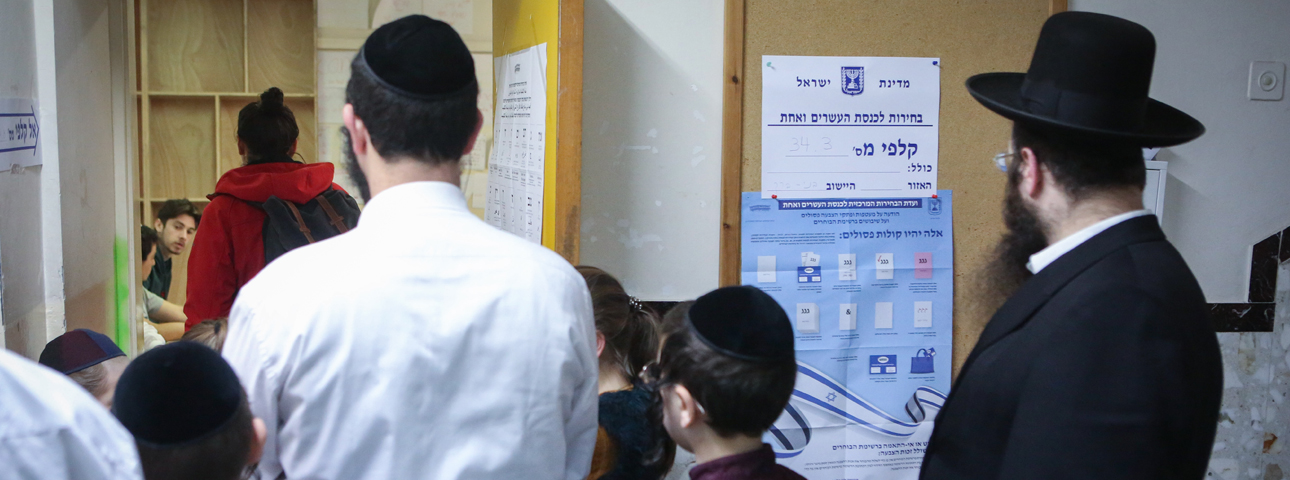Ultra-Orthodox Streamed to the Polls
Among the many surprises of last week’s election was the impressive performance by the ultra-Orthodox parties – how can we explain this dizzying success?

Flash 90
Among the many surprises of last week’s election was the impressive performance by the ultra-Orthodox parties, resulting in an increase in their representation in the Knesset from 13 to 15 seats. This achievement is even more striking, given that the pollsters had correctly anticipated that United Torah Judaism (UTJ) would indeed grow to seven mandates (and might even grow to eight), but predicted that Shas would shrink.
How can we explain this dizzying success? In view of the large number of retired generals who will be serving in the new Knesset, I will follow the standard military procedure of dividing everything into three parts. The first explanation is the population “explosion” among the ultra-Orthodox. Because the ultra-Orthodox population is younger on the average than other Israelis, the percentage of first-time voters who are ultra-Orthodox is relatively larger. An annual growth rate of 4% would have increased the number of ultra-Orthodox voters from 210,000 in the previous elections to 240,000 this year. But in fact, UTJ’s vote total is around 250,000, so population growth does not tell the whole story. Based on population growth, Shas, too, could be expected to gain in strength, but less dramatically, given that about a third of its voters are not ultra-Orthodox.
A second source of these parties’ success is the return of their prodigal sons from Eli Yishai’s Yahad list. Four years ago, when Yishai joined forces with Otzma Yehudit, the two parties received enough votes to win three seats, of which one came from ultra-Orthodox voters. This time, Yishai and Yahad dropped out at the last minute and threw their support to UTJ. In fact, the percentage of voters for parties other than UTJ and Shas dropped in all ultra-Orthodox communities. In Bnei Brak, for example, it fell from 17% in 2015 to 12% this year; in Beitar Illit, from 17% to 10%. Evidently Yahad supporters split their vote between UTJ, which their spiritual leader Rabbi Mazouz had instructed them to support, and Shas, their natural political home. And so, we may conclude that the two parties grew at a similar rate in most of the centers of the ultra-Orthodox community.
The rise in support for Shas came mainly from ultra-Orthodox towns, and not from non-Haredi voters in the geographical periphery. For example, in Ofakim, Beersheva, Beit She’an, Tiberias, and Migdal Ha’emek, Shas remained at the same level of support as in 2015, and in a few places actually won fewer votes. If we consider the Likud’s successful poaching of voters from the New Right and Zehut, even this is a significant achievement.
Finally, the success of the ultra-Orthodox parties can also be attributed to the failure of other lists. In these elections, no fewer than 8% of the valid ballots were thrown away on parties that did not reach the election threshold. This is double the percentage of votes going down the drain as compared with four years ago, when the figure was only 4%. A direct result is that the spoils of victory—120 seats in the Knesset—were divided among fewer lists. Shas and UTJ, which signed a surplus vote agreement, benefited from this.
Ultra-Orthodox society is in the throes of change, expressed in – among other ways – mass enrollment in colleges and universities, entry into the labor market, and ever-stronger exposure to the internet. But these processes of modernization and “Israelization” have not been accompanied by changes in the community’s voting patterns, and its loyalty to the sectoral parties remains strong. There was indeed a slight increase in support for the Likud and other non-Haredi parties, such as the United Right and Zehut in ultra-Orthodox towns, but their total share did not exceed 10%, a level that has only a negligible effect on the two main players. Another factor was UTJ’s debut appearance on Facebook, in a play for such voters.
To date, the representatives of the ultra-Orthodox sector, and especially UTJ, have focused on the defense of the yeshiva world, and they have placed scant attention to more modern and better-educated groups within the community. In the course of this campaign they promised to change their attitude towards these groups, if only because of its increasing electoral power. We will soon know whether they will indeed be wise enough to fulfill these promises in the new Knesset.
This article was first published in the Jerusalem Post.
